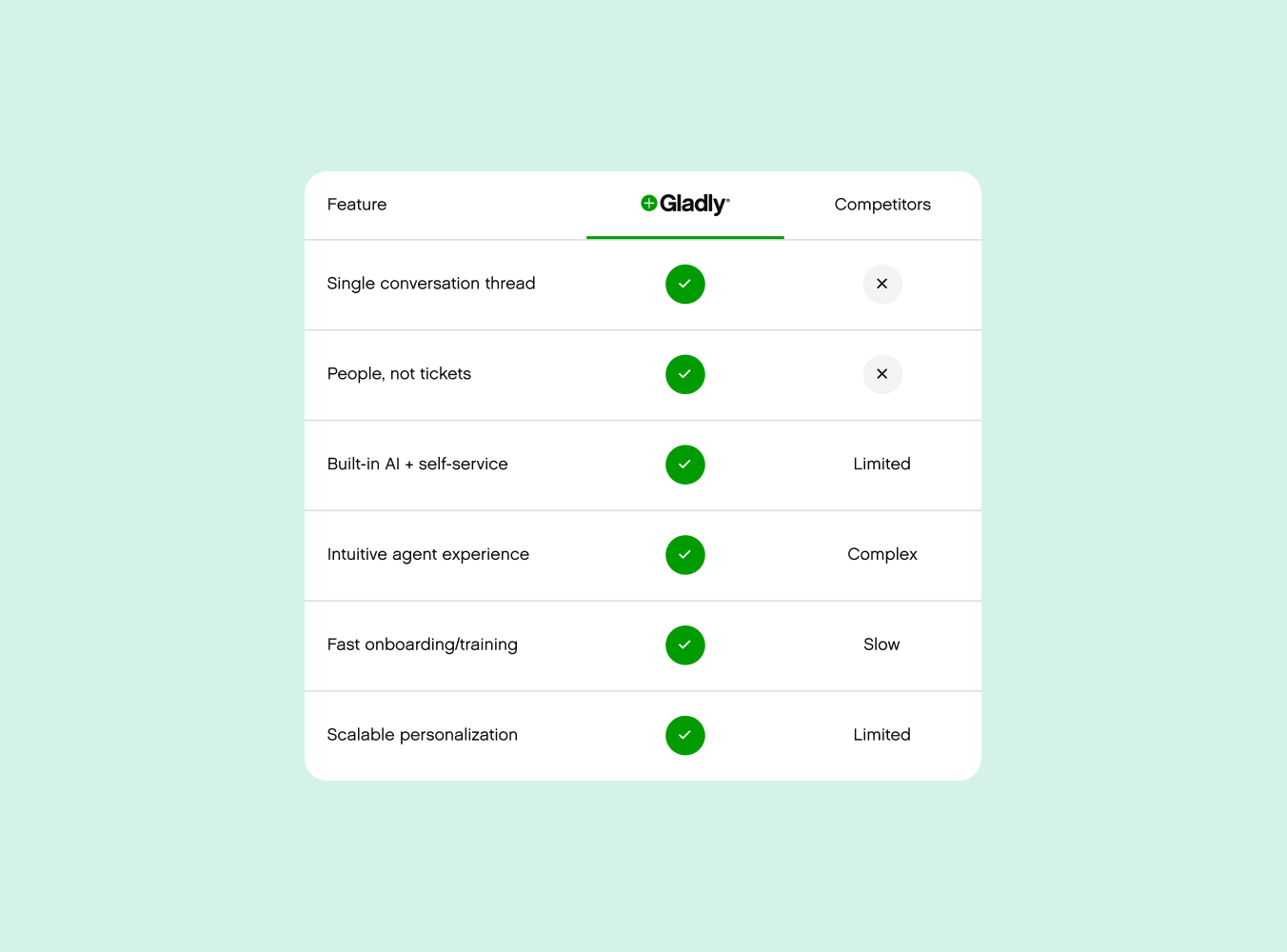November 18, 2025
Locked into your helpdesk? Locked out of better AI
The CX market is experiencing its biggest architectural shift since cloud computing. After decades of singular platforms that bundle everything together, we're entering an era where AI lives independently from your helpdesk. This isn't just a technical change. It's a strategic realignment that will determine which companies win on customer experience over the next five years..
The platform prison
Here's the uncomfortable truth most CX leaders already know. You're probably stuck in a three to five-year contract with a helpdesk platform. That's fine, but not great. Maybe it was the right choice in 2021. Now you're locked in.
Meanwhile, AI capabilities have exploded. What seemed impossible 18 months ago is now table stakes. Companies can automate 30 to 50 percent of customer inquiries easily, but only if they can deploy AI quickly and correctly.
The traditional answer was to wait. Finish your contract. Then switch to a platform with better AI built in. But that logic breaks down when you do the math.
Let's say you handle 100,000 customer contacts per month. At an average cost of $4 per contact, that's $400,000 monthly or $4.8 million annually. If AI can resolve even 25 percent of those interactions, you're leaving $1.2 million per year on the table. Multiply that by three years left on your contract, and you've just walked away from $3.6 million.
That's the real cost of the platform prison. Not the contract penalty. The opportunity cost of waiting.
Why independence matters
Platform-native AI sounds convenient. You're already using what you have, so why not just turn on their AI features?
But platform-native AI optimizes for the platform, not for your customers.
Note.
Think about how these systems are built. Zendesk AI, for example, is designed to reduce ticket volume in Zendesk. It's excellent at what it does, but this function only serves the platform's architecture, not your customer experience strategy.
Here's a test. Ask yourself what happens when a customer contacts you on chat, then follows up via email, then calls. Does your platform-native AI maintain context across all three interactions? Does it understand that the frustrated person on the phone is the same one who unsuccessfully tried to get help via chat yesterday?
They likely won't. These platforms are channel-specific automations with shallow memory. They deflect individual tickets efficiently, but they fragment the customer journey.
Gladly AI, by contrast, sits above your helpdesk infrastructure. It can pull context from anywhere. Past purchases. Browsing behavior. Previous conversations across all channels. It's not constrained by the data model of whatever ticketing system you happened to buy three years ago.
This is the difference between ticket-centric AI and customer-centric AI. One treats each interaction as an isolated problem to deflect. The other understands that customers are people with histories, preferences, and relationship expectations that span multiple touch points.
When Rothy's deployed Gladly AI, they saw 37% resolution rates and 34% reduction in AHT. The AI wasn't just answering questions. It was applying customer context to deliver resolutions that felt personal. That's what happens when your AI is built to understand people, not just process tickets.
The integration complexity question
Now for the hard part. If standalone AI is so great, why isn't everyone using it?
Because integration is supposedly hard and usually takes months. You need to connect the AI to your knowledge base, your order management system, your CRM, and your inventory database. Then you need to train it on your products, policies, and brand voice.
But this implementation bottleneck has collapsed. Modern standalone AI can ingest your knowledge much faster. Setup that took 90 days now takes a few weeks.
But let's be specific about what "easy" actually means. Some vendors claim you can live in an hour. That's marketing. The reality is more like this.
Day one, you connect your knowledge sources and configure basic handoff rules. Day two through five, you test responses and refine the AI's understanding of your brand voice. Week two, you go live on a single channel with a small percentage of traffic. Week three, you expand gradually while monitoring quality.
That's not an hour. But it's also not six months. And crucially, it doesn't require engineers. CX teams can own the entire process with the right tools. At Gladly, we've seen customers go from kickoff to live in just a few weeks because the setup is designed for CX admins, not IT departments. No-code doesn't mean no effort. It means no bottlenecks.
The question isn't whether you can integrate standalone AI. The question is whether you can afford to wait while your platform vendor builds comparable capabilities.
What actually matters in standalone AI
Not all standalone AI is created equal. The market is flooded with chatbots that claim to be "autonomous agents", but really just match keywords to canned responses.
Here's what separates real AI from sophisticated automation.
Context depth. Can the AI see what the customer bought six months ago? Can it recognize that this is the third time they've contacted you about the same issue? Can it adjust its tone based on whether the customer is frustrated or just curious?
Most AI tools are contextually shallow. They know what's in the current conversation and maybe what's in your knowledge base. That's it. But customer service isn't a one-turn interaction. It's a relationship. The AI needs to understand relationship context to deliver relationship-quality service.
This is where customer-centric AI pulls ahead. When every interaction is grounded in the full customer history, the AI doesn't just sound more personal. It makes smarter decisions about what to recommend, when to escalate, and how to communicate.
Action capability. Answering questions is table stakes. Can your AI process a return? Update a shipping address? Apply a discount code? Issue a refund?
This is where most "chat-first" AI falls apart. It's conversational, but not functional. It can tell customers how to fix their problem but can't actually fix it for them. The result is friendly dead ends that still require agent intervention.
True resolution requires true action capability. The AI needs to connect to your systems of record and execute on behalf of customers. Not just look things up. Actually complete the task.
Channel coverage. Be specific here. When vendors say "omnichannel," ask which channels they mean.
Some standalone AI only works on web chat. Others cover chat, SMS, and email but treat voice as an afterthought requiring third-party integrations. The best cover all digital channels natively and hand off to voice seamlessly when needed.
Why does this matter? Because customers don't think in channels. They think in problems. And problems that start via chat often need to escalate to voice. If your AI can't maintain context through that escalation, you've just created customer frustration in the name of automation.
The business model question
Here's where things get uncomfortable. How do you measure value?
Platform vendors typically price on seats or contacts. You pay per agent or per interaction, regardless of outcome. This made sense in a pre-AI world where every contact required human handling.
But AI changes the math. A conversation that gets resolved without agent intervention shouldn't cost the same as one that requires escalation. Yet volume-based pricing treats them identically.
The emerging model is outcome-based pricing. Pay for resolutions. Pay for successful automation. Don't pay when the AI hands off to a human.
This sounds obvious, but it requires both sides to have confidence in the system. You need to trust that the AI actually resolves issues, rather than just deflecting them. The vendor needs to trust that you'll scale usage as value becomes clear.
That alignment only works if the AI truly delivers end-to-end resolutions. Which brings us back to context, actions, and channel coverage. Those capabilities aren't luxury features. They're the foundation that makes outcome-based pricing viable.
Gladly is designed for customers, not tickets
The path to great AI
If you're a CX leader at a mid-size to enterprise company, you're facing a decision point. Not whether to adopt AI, but how to deploy it strategically.
The old playbook said to wait for your platform to build AI features, then adopt them when ready. That playbook assumed slow technology change and high switching costs.
The new reality is different. AI capabilities are advancing monthly, not yearly. The switching cost of standalone AI is low. And the opportunity cost of waiting is measurable in millions of dollars annually.
So here's the framework for making this decision.
First, calculate your actual opportunity cost. Take your monthly contact volume, multiply by your cost per contact, then multiply by a conservative 25 percent automation rate. That's your annual opportunity. If the number makes you uncomfortable, standalone AI deserves serious consideration.
Second, audit your current platform's AI capabilities honestly. Not the roadmap promises. The actual, available-today functionality. Can it handle complex, multi-turn conversations? Can it take action? Can it maintain context across channels? If the answer is no or not yet, you're leaving value on the table.
Third, model the implementation timeline. How long would it take to deploy standalone AI? How does that compare to waiting for your platform vendor to ship comparable features? Time is the variable that kills most ROI calculations.
Fourth, assess your team's readiness. Do you have people who can own AI configuration and optimization? This doesn't mean engineers. It means CX professionals who understand customer journeys and can translate them into automation logic.
If all four factors align, standalone AI stops being an experimental side project and becomes a strategic imperative.
The implementation reality check
Let's end with honesty. Standalone AI isn't plug and play. No AI is.
You'll spend time configuring handoff rules. You'll discover edge cases where the AI doesn't understand your specific business logic. You'll need to train it on product updates and policy changes. Some percentage of automated conversations will be wrong or unhelpful in ways that frustrate customers.
This is not just normal; it's needed to succeed.
Companies seeing 30 to 40 percent resolution rates didn't get there in week one. They got there by deploying quickly, monitoring closely, and iterating constantly. They treated their first month as a learning period, not a success metric.
What separated winners from those who struggled wasn't technical sophistication. It was organizational readiness. The winners had executive sponsorship, clear success metrics, and dedicated resources for ongoing optimization. The strugglers treated AI as an IT project that would magically work once configured.
So if you're considering standalone AI, ask yourself one question. Are you ready to own this? Not just buy it, but actively manage it as a core customer experience capability?
If yes, the path forward is clear. If no, then waiting for your platform vendor to ship something isn't actually a strategy. It's avoidance dressed as patience.
The future is customer-centric, not platform-centric
This distinction matters. Because the metrics you optimize for determine the experiences you deliver. Optimize for deflection, and you get efficient dismissal. Optimize for resolution, and you get meaningful help. Optimize for customer-centricity, and you get loyalty.
This is why Gladly exists. Here, customers are people, not tickets. AI makes service more personal, not less. And companies are partners, not just another logo on a page.
Gladly brings that philosophy to you. Whether you're on another platform, you can deploy customer-centric AI that delivers radically personal experiences across chat, SMS, email, and voice. You can go live in weeks, not months. And you can prove value before making any platform decisions.
Recommended reading

Stop choosing between cost and quality — Gladly lets you have both
Gladly offers a solution to the customer service crisis, combining AI and live agents.
By
Angie Tran

AI in customer service for SMBs
Power SMB customer service with AI. Learn AI, machine learning, and NLP, and find out how to implement smart solutions that delight customers and drive growth.
By
Angie Tran

See how Gladly compares
Discover how Gladly stacks up against Zendesk, Salesforce, Genesys, Freshdesk, Kustomer, Gorgias, Sierra, and Decagon.
